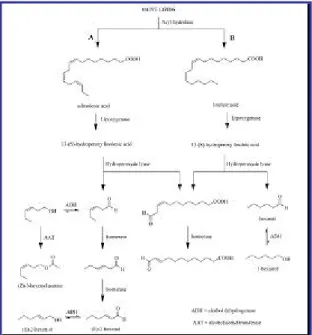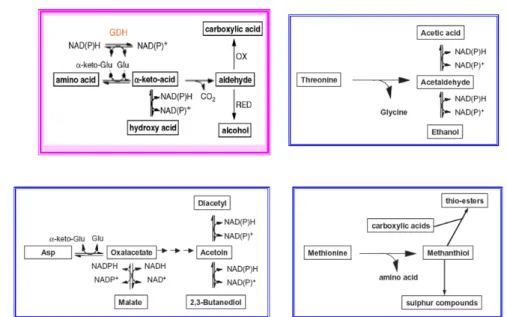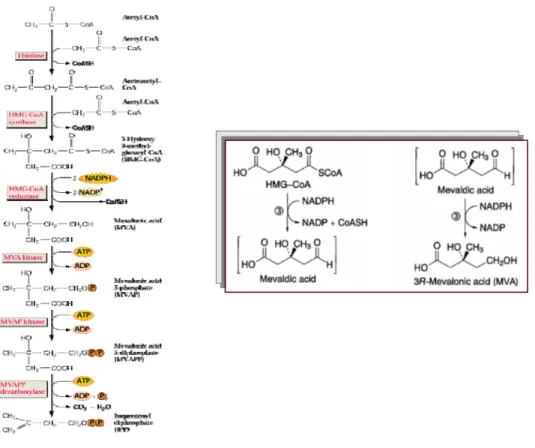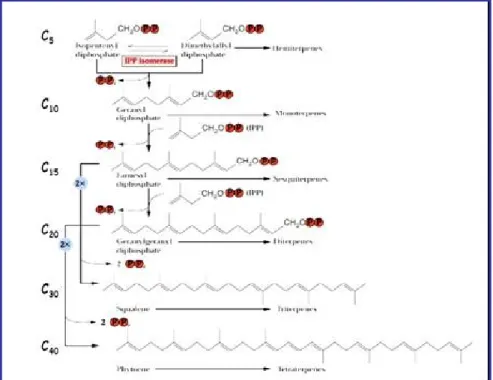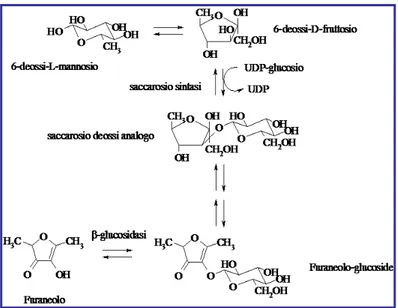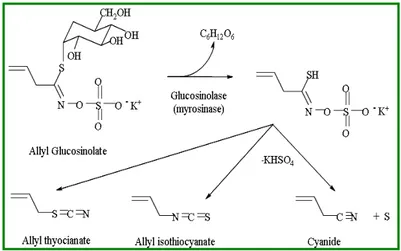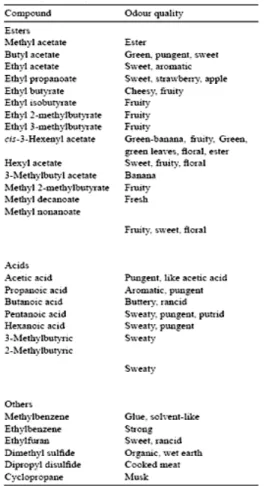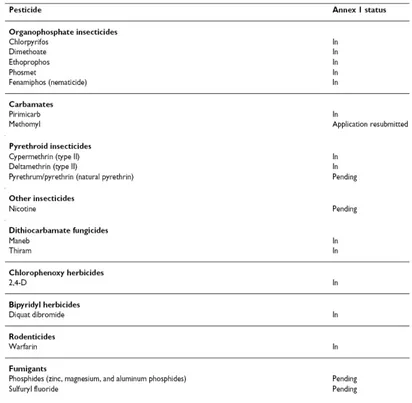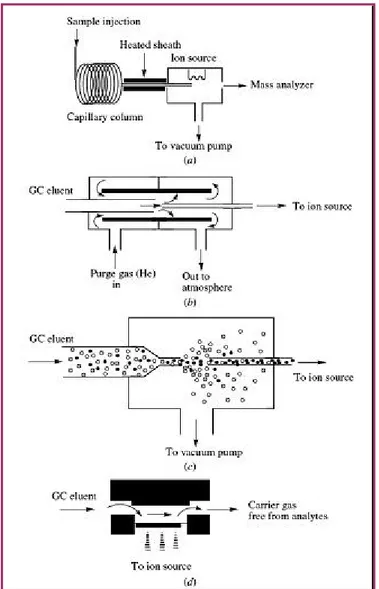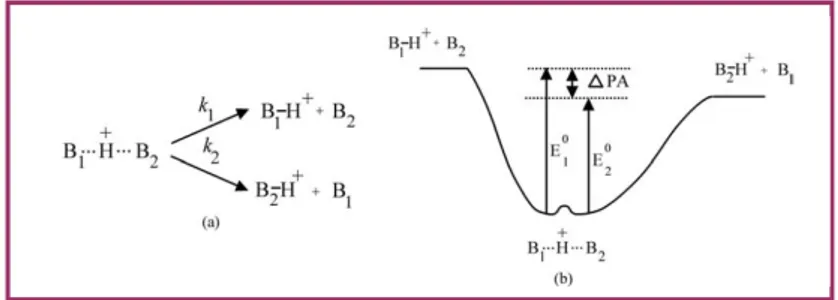Contents
Chapter 1
Food quality and safety
1.1 Food traceability 3
1.1.1 The importance of food traceability and safety 5 1.1.2 Analytical methods used in food traceability and safety 6 1.2 Metabolomics applications in food traceability 9 1.2.1 Flavor formation in fruits and vegetables 11 1.2.2 Biogenesis of flavor compounds in fruits 12 1.2.2.1 Aroma compounds from fatty acid metabolism 14 1.2.2.2 Aroma compounds from amino acid metabolism 15 1.2.2.3 Aroma compounds formed from carbohydrate metabolism 17 1.2.3 Biogenesis of flavor compounds in vegetables 21
1.2.4 Glycosidically bound aroma compounds 22
1.3 Olive oil 24
1.3.1 Olive oil aroma biogenesis 25
1.3.2 Effect of agronomic and technological aspects on the volatile
fraction of olive oil 28
1.4 Tomato 32
1.4.1 Tomato aroma biogenesis 34
1.5 Chemical contaminants in food 37
1.5.1.1 Methods used for assaying of phthalates 43
1.5.2 Pesticides 46
1.5.2.1 Organophosphate insecticides: Dimethoate 50 1.5.2.1.1 Toxicological effects of dimethoate 52
References 55
Chapter 2
Mass spectrometry: applications on foodstuffs
2.1 Hyphenated separation techniques 73
2.1.1 Benefits of coupling separation devices with mass spectrometry 73
2.1.2 Characteristics of an Interface 75
2.1.3 Mass Spectral Data Acquisition 75
2.2 Gas chromatography/mass spectrometry 77
2.2.1 Basic Principles of Gas Chromatography 77
2.2.2 Interfaces for Coupling Gas Chromatography with Mass Spectrometry 78
2.3 Liquid chromatography/mass spectrometry 80
2.3.1.Basic Principles of HPLC Separation 81
2.3.2 Fast-Flow Liquid Chromatography 82
2.3.3 Interfaces for coupling liquid chromatography with mass spectrometry 83 2.3.3.1 Electrospray Ionization (ESI) and atmospheric pressure
chemical ionization (APCI) interfaces 84
2.4 Tandem mass spectrometry 88
2.4.1 Tandem MS analyzer combinations 90
2.4.1.1 Tandem-in-Space 91
2.4.1.1.1 Triple-Quadrupole 92
2.4.1.1.2 Tandem Time-of-Flight 93
2.4.1.1.3 Quadrupole-Time-of-Flight 95
2.4.1.2.1 Quadrupole Ion Traps 96
2.4.2 Ion activation methods 99
2.4.3 Tandem Mass Spectrometry Applications 102
2.5 Quantitative analysis: advantages of mass spectrometry 105
2.5.1 Selected-Ion Monitoring 106
2.5.2 Selected-Reaction Monitoring 107
2.5.3 Specificity, Sensitivity and Detection Limit 108
2.5.4 Calibration methods 110
2.5.5 Validation of a quantitative method 115
2.6 Applications of Mass Spectrometry in Food Analysis 116
2.7 Multivariate statistical analysis 120
2.7.1 Discriminant Analysis 121
2.7.1.1 Mahalanobis Distance and Linear Discriminant Functions 124
2.7.1.2 Selection of variables 126
2.7.2 Soft Independent Modelling of Class Analogy (SIMCA) 126
References 131
Scope of the thesis
137Chapter 3
Results and discussion
3.1 A metabolomic approach to the evaluation of the origin of extra virgin olive oil: A convenient statistical treatment of mass spectrometric
analytical data 139
3.1.1 Experimental conditions 141
3.1.2 Results and discussion 145
3.2 Geographical characterization of tomato by SPME-GC/Ion Trap Mass Spectrometry analysis of volatile components
and chemometric treatment. 154
3.2.1 SPME optimization 155
3.2.2 Statistical analysis 158
3.3 Tandem mass spectrometry in food safety assessment:
The determination of phthalates in olive oil. 166
3.3.1 Sample extraction and clean-up step 169
3.3.2 GC-ion trap MS analysis 169
3.3.3 Comparison of MS/MS acquisition with SIM mode 174 3.4. Screening of dimethoate in food by isotope dilution and
electrospray ionization tandem mass spectrometry. 178
3.4.1 Synthesis of d3-labeled dimethoate 180
3.4.2 Sample preparation 182
3.4.3 Analytical parameters 184
References 188
Chapter 4
Experimental
4.1 A metabolomic approach to the evaluation of the origin of extra virgin olive oil: A convenient statistical treatment of mass spectrometric
analytical data 197 4.1.1 Materials 197 4.1.2 Experimental Procedure 197 4.1.3 Preparation of Samples 197 4.1.4 Instrumentation 198 4.1.5 Statistical Analysis 198
components by SPME-GC/Ion Trap Mass Spectrometry 199 4.2.1 Materials 199 4.2.2 Experimental Procedure 199 4.2.3 Preparation of Samples 199 4.2.4 Instrumentation 200 4.2.5 Statistical Analysis 200
4.3 Tandem mass spectrometry in food safety assessment:
The determination of phthalates in olive oil. 201
4.3.1 Materials 201
4.3.2 Instrumentation and apparatus 201
4.3.3 Calibration procedure 202
4.3.4 Samples 202
4.4 Screening of dimethoate in food by isotope dilution and electrospray
ionization tandem mass spectrometry. 204
4.4.1 Chemicals 204
4.4.2 Synthesis of d3-labeled dimethoate 204
4.4.3 Sample preparation 205
______________________________________________________________________
1.1 Food traceability
The Codex Alimentarius Commission (1999)1defined traceability as the ability to trace
the history, application or location of an entity by means of recorded identifications. Traceability is closely linked to product identity, but it can also relate to the origin of materials and parts, product processing history, and the distribution and location of the product after delivery. The European Union has attached to traceability and labeling the solution to consumer concern about mad cow disease, dioxin in chicken feed, and GM food products.
Traceability became a political matter when the European Commission approved proposals requiring the traceability and labeling of GM foods, including highly-refined starches and oils in which unaltered DNA or proteins cannot be detected.
Food manufacturers develop and adopt internal traceability systems and traceability chains mainly to improve food safety, since traceability can be seen as a subsystem whose presence is essential to the management of food quality.2 Traceability is an essential tool for ensuring both production and product quality.3,4 The opportunity to connect traceability with the whole documentation and control system represents an effective means for boosting the consumer’s perception of a food safety and quality.5
Meanwhile, the Codex Committee on General Principles has been asked to examine the role of traceability as a potential risk management tool for public health purposes. Other Codex committees will seek to determine how traceability might be used in their standards and guidelines.
Regulation EC No 178/2002, 2002,6which provides the legal basis for the establishment of the European Food Safety Authority (EFSA), defines traceability as the ability to trace and follow a food, feed, food-producing animal or substance intended to be, or expected to be incorporated into a food or feed, through all stages of production, processing and distribution.
Through the documented identification of material flows and operator chains, the UNI 10939, 2001 considers traceability in food chains as a system which enable a product’s history to be reconstructed and its use followed up.7This standard provides the overall
______________________________________________________________________ 11020, 2002 establishes the principles and requirements for the development of internal traceability systems in the farming and food industries.8
At the same time, these standards provide that industry identifies Critical Control Points with a view to monitoring traceability systems and defining methods for their monitoring, assessment and documentation.
Moreover, traceability systems represent the most suitable tool for circulating information on product quality to end consumers, and for making the manufacturing system and the whole supply chain more transparent.
They also enable the identification of the parties responsible for the production of a given food and the transfer of this information to the consumers, who, as a consequence, may become more loyal customers.2,3,9
In order to develop a traceability system, the whole system must ensure that all the information concerned is quickly and easily available to the person involved in the activities and flows of the production process.10,11
Many papers emphasize that the main difficulties lie in the design of an internal traceability system for a given, complex production process.4,5 They showed that a good
system for internal quality control and traceability of a production process can yield several competitive advantages such as:
ª improving process control, through cause-and-effect indications for products that do not conform to the company standards;
ª directly linking end product and raw material data, which can help to improve specific production processes and ensure a better use of raw materials in the final product;
ª avoiding the uneconomical and unrewarding mixing of high-quality and low-quality raw materials;
ª carrying out an easier quality auditing process.
The desire for the integration of more and more information in food production management and the increasing demands for information along the food processing chain will set higher requirements for well structured traceability systems in the future. There is a need for more work on analysis of the fundamental and practical aspects of traceability in food manufacture. From this, guidelines that can help companies to
______________________________________________________________________ assess their particular need for the degree of detail in their internal and chain traceability systems can be made.
In the future, the information owing in the food manufacturing chain might provide a competitive advantage since it can be sold along with the product.
1.1.1 The importance of food traceability and safety
The market for imported, premium priced foods has increased dramatically over recent years, a consumers become ever more aware of products originating from around the world. There are many foods products that are of superior quality (taste, texture, fragrance etc.) because of the local in which they are cultivated. Environmental conditions, such as local climate and soil characteristics, combine to yield crops that exhibit specific traits. Clearly, higher quality products demands higher market prices, therefore unscrupulous traders may attempt to increase profits by deliberately mislabeling foods, or by increasing the volume of a good quality batch through adulteration with sub-standard produce.
There may also be safety issues attached to food adulteration, for example powdered or smashed hot chili pepper imported from India and Pakistan was heavily contaminated with a carcinogenic azo dye known as Sudan12-14.
Many people are allergic to cow’s milk and therefore choose milk, cheese and yoghurt from other animals, such as ships and goats. But in many cases, if a significant quantity of cow’s milk is added to these products, without proper labeling, health problems could result. Similarly, in order to ensure consumer confidence, it is important to know that food commodities do not originated in a country where food-borne disease is an issue, e.g. British beef/BSE.
In recent years, there has been increasing legislation to protect the rights of both the consumer and honest producers.15,16To enforce there laws, a measure of the authenticity
of samples must be made, most often in the form of providing the presence/absence of adulterants, or verifying geographical or cultivar origin by comparison with known and reliable samples. The latter method often includes the use of multivariate statistical techniques to investigate sample data.17
______________________________________________________________________
1.1.2 Analytical methods used in food traceability and safety
A large number of techniques have been used for food study from safety ad authenticity point of view.
DNA analysis has been applied to prove the species origin of several meat,18,19fish,20,21 and plants products,22as a matter of concern for reasons of lifestyle, religion and health.
IR spectroscopy has been widely applied to the detection of adulterants and the assignment of geographical or cultivar origin.23 Products analyzed by this method
include fruit juice,24 olive oil,25 fish and meat, beverages, maple syrup, starch, and
honey.26
Recently, gas chromatography (GC), high performance liquid chromatography (HPLC), supercritical fluid chromatography (SFC), and capillary electrophoresis (CE) have been widely used in the authentication analysis of food products. The fat,27 protein,28 carbohydrate or other natural compound profiles29,30have been used to provide species
an geographical differentiation. In several cases, enantiomeric composition has been used.28,30 These method of discrimination rely on samples of different species and/or
different geographical origin having different chemical compositions. This is not always the case, samples from the same location have been found to contain different components and conversely samples from different regions may be display identical chemical composition.31Detectors usually used, in combination with chromatographic techniques (GC and HPLC), may be more or less selective and sensitive, but lack information about the identity of compounds. Therefore, the coupling of chromatographic techniques and mass spectrometry (MS) overcomes this drawback. MS is a sensitive and selective detector, sometimes allowing preparation steps to be avoided. GC-MS is a robust techniques, used routinely in many laboratories for food analysis, for example for the determination of aroma compounds, contaminants and pesticides analysis. More recently, LC coupled to quadrupoles, magnetic sectors or time-of-flight (TOF) detectors, has also had a great expansion into the field of food analysis. The recently introduced spray methods (ESI) have fostered qualitative and quantitative analysis of medium to high polar analytes by mass spectrometry.
The designing of ion source houses for ESI has also fostered the rediscovery of Atmospheric Pressure Ionization (API) methods such APCI where the chemical
______________________________________________________________________ ionization (CI) is achieved at atmospheric pressure. Both techniques produce soft ionization, but additional fragmentation can be achieved by performing in-source collision induced dissociation (CID) in tandem or trap instruments. MS/MS in space and in time provide additional and unique information on the structure of analytes. ESI is useful for polar and ionic solutes ranging in molecular weight from 100 to 150x103
dalton. APCI is applicable to non-polar and medium polarity molecules with a molecular weight from 100 to 2000 dalton. Although the choice of the right interface, as well as the detection polarity re based mostly on the compounds polarity and thermal stability and the HPLC operating conditions, many classes of compounds can give good response with both ionization techniques. In some cases both positive and negative ionization modes are needed, while in most of the cases the choice of only one operation mode is enough.32
The number of applications of HPLC-API-MS to food analysis has rapidly increased on recent years. ESI is much more widespread than APCI, but for both techniques the trend is towards an increase in the number and the variety of applications.33-34
Other techniques applied for food traceability studies include capillary electrophoresis, sensory arrays35and examination of physical characteristics.36This latter approach has
been shown to be subject to human inconsistencies in the case of wine tasting.37
Stable isotope techniques enable differentiation of chemically identical substances through alterations in their isotopic fingerprint and have been used in authenticity studies for many food products.38The isotopic composition of light elements in plant material can vary depending on location31but, the dominant factor is the influence of latitude on the fractionation of the elements in groundwater.39
Fractionation occurs during physical processes such as evaporation. Lighter isotopes evaporate very slightly faster than heavier counterparts, therefore in warmer regions where the amount of evaporation is higher , the isotopes are fractionated to a greater degree. The discrimination between isotopes in such physical processes is only significant for light elements, with an high relative mass difference between the isotopes.
Thus hydrogen ratios, measured by site-specific natural isotope fractionation nuclear magnetic resonance (SNIF-NMR) and carbon, nitrogen, oxygen and sulphur isotope ratios measured by isotope ratio mass spectrometry IRMS) have been applied to the
______________________________________________________________________ foods authentication. Fats and oils,30,40,41flavours,42wines,43-44fruit juice45and several
other products have been classified using stable isotope analysis.
The elemental composition of vegetation reflects the soil in which it has grown,46which in turn will depend on the topography, geology and soil characteristics, therefore, no two countries will have identical soil maps and the concentration of elements in food products can then be used to assign their geographical origin. As with other methods of traceability, a database of samples of known origin must be available, against which unknown samples can be compared.
The most useful elements for the assignment of origin are those that are not homeostatically controlled. Elements such as K, Ca and Zn are actively absorbed by organisms and will therefore be present in samples at similar levels, regardless of the environmental conditions experienced. Elements that have no role in normal physiological processes, such as the rare earth elements (RREs) and the heavy metals are passively absorbed and the concentration of these elements in an organism will strongly reflect the environmental levels to which the organism has been exposed. Several studies have used multi-element concentration profiles in the determination of food authenticity, either alone or in combination with chromatographic or stable isotope ratio data.47-48Elemental concentrations were determined by AAS,49ICP-AES50or ICP-MS.51,52
Several trace elements have variable natural isotopic abundance due to the decay of radioactive isotopes. These include Li, B, Sr, Nd, Hf, Pb and U.53The composition and
age of the local rocks dictates the abundance of the radioactive precursors and their daughter species.54This fact has been widely exploited for environmental applications,
archeology and geochronology and geochemistry. Elements are taken up into plants in the same isotopic proportions as they occur in the soil and in precipitation.55-57
Therefore isotope ratios in plant-derived food products depend on the geology of the region in which the source crop was grown and are different in produce of different geographical origin. There were, however, relatively few reports of the use of heavier stable isotope ratio measurements of the authentication of foodstuffs. For many years Thermal Ionization Mass Spectrometry (TIMS) was the only technique capable of performing isotope ratio measurements with sufficient precision to allow geographical assignment of food products based on trace element isotopic composition. Sample for
______________________________________________________________________ TIMS analysis must be loaded in the form of the pure element, meaning that extensive sample preparation is required if this technique is to be applied. Nonetheless, TIMS has been used for Sr isotopic measurements for the regional assignment of wines58 and
butter.31 In the latter case Sr, C, N, O and S isotopic profiles were subjected to
discriminant analysis, allowing assignment of the regional origin of unknown samples by comparison with samples of certified origin.
Inductively coupled plasma mass spectrometry (ICP-MS) is now a well established technique for isotopic trace element determinations.59ICP-MS allows rapid analysis of a large range of sample types, requires minimal sample preparation and due to the ionizing power of the ICP, can be applied to a wider range of elements than TIMS. The precision of isotope ratio analyses by ICP-MS has only recently matched that achievable by TIMS, through the application of double focusing mass analyzers coupled to multi-collector detection arrays. The increasing availability of multi-multi-collector ICP-MS is likely to lead to wider application of heavier stable isotope ratio measurements to the authentication of food products. Two recent reports used Sr isotope ratios measured by ICP-MS for the regional assignment of wines and the Pb isotopic profiles of port wines have also been measured by ICP-MS and found to a certain extent to depend on the age of the wine.60,61 Other studies of trace element isotope ratios for food authentication
have been carried out.62-63
1.2 Metabolomics applications in food traceability
The term “metabolome” describes the complement of all metabolites expressed in a cell, tissue or organism during its lifetime. Already at the 19th century it was suggested that two classes of metabolites exist; primary (or basic) and secondary. Secondary metabolism refers to compounds that are not needed for the cell survival and propagation but are believed to be of importance to continued existence in particular environmental conditions. Secondary metabolites are derived from primary metabolites (e.g. amino acids and carbohydrates), through modifications, such as methylation, hydroxylation, and glycosylation. Evolutionary processes directed towards enhancing plant fitness most probably stimulated formation of new structures. Secondary
______________________________________________________________________ metabolites are formed both as part of normal plant developmental pathways and upon diverse endogenous and environmental stimuli. Examples of secondary metabolites are fruit flavor and aroma compounds, flower and fruit pigments and "sun screen" metabolites such as the flavonols. Up to date, a few hundred thousand different secondary metabolites structures have been identified in plants, the largest of them are the phenylpropanoids, isoprenoids and alkaloids.
An estimated 20% of all carbon fixed in the leaves passes through the Shikimate pathway (Figure 1.2.1) and 30% of the plants dry weight comes from this pathway products, the aromatic amino acids Phenylalanine, Tryptophan and Tyrosine. These amino acids are the primary source of carbon for the formation of a myriad of secondary metabolites in both plants and microorganisms. For example, the insects deterring glucosinolates are products of Phenylalanine and Tryptophan metabolism and the phytohormone salicylic acid is produced from Chorismate, the final product of the Shikimate pathway.
______________________________________________________________________
1.2.1 Flavor formation in fruits and vegetables
Knowledge of precursors and pathways leading to the formation of flavor in fruits and vegetables has progressed slowly over the years. Historically, emphasis has been placed on determining what constitutes flavor rather than on the mechanisms of flavor formation.
Also, the task of elucidating metabolic pathways in very complex biological systems is difficult at best. The continued demand for natural flavorings has renewed interest in this research area since a knowledge of biological pathways facilitates their production under conditions that permit their labeling as natural.
Considering that flavor components are reasonably low molecular weight materials, we might expect that they are a part of the normal biosynthesis process. While this is often true for the nonvolatile components of flavor, such as sugars or acids, this is generally not true for aroma components. It is interesting that few if any aroma compounds are known to serve a biological function in the plant. In fact, most aroma compounds arise as a result of degradation reactions. In fruits, the plant cell walls soften and internal organization is lost during ripening. This loss of organization permits enzymes normally associated with growth to attack various substrates normally not available to the enzymes. Enzymes typically involved in synthetic processes are involved in degradation reactions. This attack results in the formation of a host of low molecular weight products many of which have significant sensory properties.
In vegetables, there is no ripening period in which aroma compounds are formed via enzymatic reactions upon cellular damage. If flavor is the result of an evolutionary process, it may be in how it influences animal behavior or microbial degradation. Animals may be attracted to a pleasant flavor, promoting the consumption of the plant and the spread of its seeds. An unpleasant flavor may deter an animal from eating the plant until it has had time to come to reproductive maturity. Some flavor components have antimicrobial properties that may protect the plant’s reproductive elements to enhance survival.
______________________________________________________________________
1.2.2 Biogenesis of flavor compounds in fruits
There are some important differences in the biogenesis of flavor constituents in fruits and vegetables. In general, in fruit the flavor constituents are not present during early fruit formation, but are biosynthesized in the intact tissue during a short ripening period which is strongly related to the climacteric rise in respiration.
During this period, metabolism of the fruit changes to catabolism, and flavor formation begins. Minute quantities of lipids, carbohydrates, proteins and amino acids are enzimatically converted to simple sugars or acids and volatile compounds. The rate of flavor formation reaches a maximum during the postclimacteric ripening phase.
An overall view of flavor formation during ripening of fruit is shown in figure 1.2.
Figure 1.2.2Formation of aroma fruits from major food components.
Flavors are formed from major plant constituents under genetic control. Each metabolic pathway is connected to other metabolic pathway. As direct products of a metabolic pathway, or as a result of interactions between pathways or end products, a host of volatile compounds are produced which contribute to the flavor of a ripe fruit. The precursors of some aroma compounds in table 1.2.1.
______________________________________________________________________ In most vegetables the intact tissues contain non-volatile precursors which are split by enzymatic action when the tissue is disrupted by crushing, cutting or slicing. Typical fruit volatiles include esters, alcohols, acids, lactones, carbonyls and terpenes while typical vegetable volatiles are nitrogen and sulfur compounds and carbonyls.
Nutrient Aroma Component
Carbohydrates Organic acids:
Glucose Pyruvic acid, acetic acid, propionic acid, acetoacetic acid, butyric acid, hexanoic acid, octanoic acid
Fructose Esters:
Sucrose Pyruvates, acetates, propionates, butyrates, acetonacetates, hexanoates, octanoates Alcohols :
Ethanol, propanol, butanol, hexanol, octanol Aldehydes :
Acetaldehyde, propanal, butanal, hexanal, octanal Terpenes:
Monoterpene, linalool, limonene, α-pinene, citronellal, citral, geranial
Amino acids Pyruvic acid, acetaldehyde, ethanol
Alanine isopropanal, isopropanol, α-keto-isobutyric acid Valine 3-methylbutanal, 3-methylbutanol, α-keto-isocaproic
acid
Leucine 2-methylbutanal, 2-methylbutanol
Isoleucine Benzaldehyde, phenylacetaldehyde, cinnamaldehyde, Phenylalanine hydroxycinnamaldehyde, hydroxybenzaldehyde,
p-hydroxyphenylacetaldehyde, p-hydroxycinnamaldehyde Serine
Threonine Pyruvic acid
Glycine Thiazoles
Cystine/cysteine Glyoxal
Fatty acids Trans-2-trans-4-decadienale, trans-2-octenal, Linoleic
acid/Linolenic acid
Trans-2-pentanal, trans-2-hexenol, hexanal, cis-3-hexenal, cis-3-hexenol, trans-2-trans-4-heptadienal, propanal
Vitamins
Carotene β-ionone
β-carotene
______________________________________________________________________
1.2.2.1 Aroma compounds from fatty acid metabolism
Volatile flavor compounds may be formed from lipids via several different pathways. The primary pathways include α- and β-oxidation via lipoxygenase enzymes. The widest variety of flavor compounds formed from lipids arises via lipoxygenase activity. Many of the aliphatic esters, alcohols, acids and carbonyls found in fruit and vegetables are derivative from the oxidative degradation of linoleic and linolenic acids. Different studies on the generation of flavor in banana,64 tomato,65 apple, tea66 and olive oil67
elucidate and point out the importance of lipoxygenase activity to flavor development in fruit (Figure 1.2.3).
Acids and ketones as well as other intermediates in the oxidation process are readily converted to alcohols, aldehydes and esters by other enzyme systems in the plant. Both
α- and β-oxidation pathways have been demonstrates to exist thereby providing a wide range of volatiles for further conversion to flavor compounds. The discussion above outlines how many volatile compounds are formed from lipid degradation. Yet, one may be inclined to question the importance of these pathways since there is very little lipid in fruits. First, one must recognize that many aroma compounds have low sensory thresholds. It does not take much precursor to yield ppm quantities of aroma compounds. Second, there is a significant quantity of linoleic and linolenic acid in plant chloroplasts. As fruits ripen, they loose their green color due to chloroplast degradation, which then releases membrane lipids which are rich in these key aroma precursors. These precursors then enter the pathways described above to form the host of esters and carbonyls that characterize the aroma of many fruits.
______________________________________________________________________
Figure 1.2.3 Metabolic pathway for the origin aliphatic aroma compounds via lipoxygenase enzymes.
1.2.2.2 Aroma compounds from amino acid metabolism
Amino acid metabolism generates aromatic, aliphatic and branched chin alcohols, acids, carbonyls and esters that are important to the flavor of fruit. Yu et al.68were amongst the earliest researchers to demonstrate that valine, leucine, alanine and aspartic acid can be converted to short chain carbonyls by tomato extracts. The enzymes involved in these transformations were found to be located in different sites of fruit. In tomato, in fact, the soluble fraction isolated via centrifugation acted on leucine while the mitochondrial fraction metabolized both alanine and aspartic acid.
______________________________________________________________________
Figure 1.2.4Principal reactions involved in the formation of aroma compounds from amino acids.
Although aldehydes and alcohols derived from the degradation of branched-chain and aromatic amino acids or methionine constitute a class of highly abundant plant volatiles, their pathways have been barely analyzed in plants (Figure 1.2.4). Especially important are branched-chain volatiles derived from branched-chain amino acids. Isoamyl acetate, an ester with a strong fruity odor described as similar to banana or pear, is one of the key constituents of banana flavor.692-methyl-butyl acetate has a strong apple scent and
is associated with apple varieties that are rich in aroma such as ‘Fuji’, ‘Gala’ and ‘Golden Delicious’.70,71Methyl 2-methyl butanoate determines the characteristic aroma
of prickly pear,72 while a combination of several volatile esters imparts the unique
aroma of melons, with isoamylacetate and 2-methyl-butyl acetate being prominent in many varieties.73
______________________________________________________________________
Figure 1.2.5Biosynthesis of amino acid-derived flavor compounds. (a) Catabolism of branched-chain amino acids leading to methyl branched flavor compounds, and (b) postulated biosynthesis of sotolon. Formation of aldehyde (a) from amino acids requires the removal of both carboxyl and amino groups. The sequence of these removals is not fully known and could be the opposite to that shown or aldehyde could be formed in one step by aldehyde synthase.74
1.2.2.3 Aroma compounds formed from carbohydrate metabolism
Observing the table 1.2.1, one can see that a large variety of volatile flavors can be traced to carbohydrate metabolism. Considering plant metabolism, it is clearly established that plants obtain all of their energy directly from photosynthesis. The photosynthetic pathways involve turning CO2 into sugars that are metabolized into other
plant needs, lipids and amino acids. Therefore, nearly all plant flavors come indirectly from carbohydrate metabolism since all of the other flavor precursors come from carbohydrate metabolism. However, there are few flavor constituents that come directly from this metabolism.
Terpenes, for example, arise both from carbohydrate and lipid metabolism.
Terpenes are classified by the number of isoprene units they contain. Monoterpenes contain two isoprene units (10 carbons), sesquiterpenes contain three isoprene units (15 carbons) and diterpenes contain four isoprene units (20 carbons). Of these groups, the
______________________________________________________________________ monoterpenes, and more specifically, the oxygenated monoterpenes, are considered most important to the aroma of certain fruits, such as citrus products.
Limonene, a monoterpene hydrocarbon possessing little odor, is the major terpene in most citrus oils accounting for up to 95% of some oils. The oxygenated terpenes, often comprising less than 5% of the oil, generally provide the characteristic flavor of different citrus species.
The biosynthetic pathway proposed for the synthesis of isopentenyl diphosphate (IPP, isoprene building block) is shown in figure 1.2.6.
Figure 1.2.6The biosynthetic pathway proposed for the synthesis of isopentenyl diphosphate, IPP. This step is catalyzed by hydroxymethylglutaryl-CoA (HMG-CoA) reductase.
This pathway combines three acetyl-Co-A molecules to form 3-hydroxy-3-methylglutaryl-Co-A (HMG-CoA). The HMG-CoA is reduced to mevalonic acid which is then phosphorylated and decarboxylated to form IPP, the key building block in
______________________________________________________________________ terpene biosynthesis. Some researchers has found that IPP can also be formed via a pathway that does not include mevalonic acid.75 While there is evidence to support the
existence of this alternative pathway, it has not been adequately determined.
The next series of steps involves the combination of IPP units to form geranyl diphosphate, farnesyl diphosphate and geranylgeranyl diphosphate, which serve as the precursors of the mono-, sesqui- and diterpene families, respectively, figure1….. In effect, all of the other members of these families arise from the cyclization or secondary modification of these three precursors.
Figure 1.2.7Formation of different families of terpenes from the universal precursor isopentylphosphate (IPP).
In addition to terpenes, carbohydrates serve as a precursor of furanones in plants. The formation of 2,5-dimethyl-4-hydroxy-2H-furan-3-one (DMHF) is an example (Figure 1.2.8). Incorporation experiments using labeled precursors revealed that D-fructose-1,6 diphosphate is an efficient biogenetic precursor of furaneol. In strawberry (Fragaria ananassa) and tomato (Solanum lycopersicum), the hexose diphosphate is converted by
______________________________________________________________________ an as yet unknown enzyme to 4-hydroxy-5-methyl-2-methylene-3(2H)-furanone, which serves as the substrate for an enone oxidoreductase recently isolated from ripe fruit.76,77
Figure 1.2.8Formation of 2,5-dimethyl-4-hydroxy-2H-furan-3-one (DMHF) in strawberry fruit.
Furanones and pyrones are important fruit constituents or have been isolated from the bark and leaves of several tree species.78Although hexoses and pentoses are the primary
photosynthetic products and serve as excellent flavor precursors in the Maillard reaction, only a limited number of natural volatiles originate directly from carbohydrates without prior degradation of the carbon skeleton. Such compounds include the furanones and pyrones.79
The furanones are mutagenic to bacteria and cause DNA damage in
laboratory tests. However, they are also very effective anti-carcinogenic
agents in the diets of animals, and their antioxidant activity is comparable
to that of ascorbic acid.
80______________________________________________________________________
1.2.3 Biogenesis of flavor compounds in vegetables
As mentioned earlier, the process leading to aroma formation in vegetables is quite different than that of fruits. Vegetables do not have a ripening period as fruits do. While some vegetables will develop flavor during growth, much of taste and a limited number of aroma compounds, the remaining flavor, particularly aroma, develops during cellular disruption.
Cellular disruption permits the mixing of enzymes and substrates, which had been separated within the cell, thereby resulting in the generation of volatile substances. A few examples of vegetables that contain a typical aroma prior to cellular disruption are celery, containing phthalides and selines, asparagus, with 1,2-dithiolane-4-carboxylic acid, and bell pepper, containing 2-methyl-3-isobutyl pyrazine.
Similar to aroma development in fruit, fatty acid, carbohydrate and amino acid metabolism serve to provide the precursors of vegetable aroma.
However, while sulfur-containing volatiles are important to some fruits, for example passion fruit, grapefruit or pineapple sulfur-containing are generally much more important to vegetable flavor. This is due to the type of sulfur-containing flavor precursors present in vegetables respect to fruits. In fresh vegetables, thioglucosinolates and cysteine sulfoxides serve as primary precursors.
Most of the vegetables belonging to the Cruciferae family depend to varying degrees on glucosinolate precursors for aroma. More than 50 different glucosinolates have been identified. Glucosinolates are nonvolatile flavor precursors, which are ezimatically hydrolyzed to volatile flavors when cellular structure is disrupted.
The initial products are isothiocyanates and nitriles. Secondary reactions lead to the formation of several other classes of flavor compounds. Figure 1.2.9 outlines the pathway proposed to explain the formation of flavor compounds in different vegetables belonging to Cruciferae species.
______________________________________________________________________
Figure 1.2.9Conversion of glucosinolate precursors to aroma compounds by myrosinase enzyme.
The glucose moiety is initially hydrolyzed from the glucosinolate. This results in an unstable molecule that readily splits out HSO4-. Depending upon molecule
rearrangements, either an isothiocyanate or a nitrile result. Further reactions result in the formation of thiols, sulfides, disulfides and trisulfides.
Terpenes also are rather common to vegetables. They arise from mechanisms similar to those active in fruit biosyntheis.
1.2.4 Glycosidically bound aroma compounds
Some aroma compounds are bound as glycosides in fruits and vegetables, and thus make no contribution to food aroma unless released. They may be released from the carbohydrate moiety during maturation, storage, processing, or aging by enzymes, acid or heat. Since their discovery, this has been a very active area of research. At this time, more than 50 plant families have been found to contain glycosidically bound aroma precursors.
Research has been driven by two factors, the first being the desire to enhance flavor strength, or yield, in an application. The pool of glycosidically bound aroma compounds in some plants exceeds the free aroma pool as much as 10:1, thus the ability to free this aroma pool would appear to be desirable. A second factor driving research is that the aging of some products, most notably wine, was postulated to be related to the freeing
______________________________________________________________________ of some of the bound aroma constituents over time, thereby maturing or balancing the aroma. If one could determine how to free the bound aroma components, it may be possible to obtain aged wines more quickly. There was not only academic interest behind this research but also considerable financial implications.
Glycosidically bound flavor compounds typically exist as glucosides, diglycosides or triglycosides. The aglycone, flavor compound, is normally bound to glucose and the remainder of the glycoside may be composed of a number of other simple sugars such as rhamnose, fructose, galactose or xylose. Over 200 aglycones have been found including aliphatic, terpene and sesquiterpene alcohols, norisoprenoids, acids, hydroxyl acids and phenylpropane derivatives as well as related compounds (Figure 1.2.10).
Figure 1.2.10Main glycosidically bound aroma compounds found in fruits.
As mentioned earlier, the aglycones may be freed from the glycosides by acid, heat or enzyme catalysis. In many fruit juices, the pH is low enough to cause slow hydrolysis during storage. This accounts for some flavor changes during aging/storage of fresh plant foods.
The aglycones may also be freed by enzymatic action. An example where this is a major pathway to release is in vanilla. There is very little free vanillin in the green vanilla bean, because it is bound as a glucoside. The making of vanilla requires a curing step where glucovanillin is converted to free vanillin by an endogenous •-glucosidase
______________________________________________________________________ freeing it for extraction.81 most often this enzymatic freeing of aglycones is a slow
process since the enzymes responsible for this hydrolysis are inhibited by low pH, typical of fruit juices.
The most part of all metabolic pathways described in this chapter are strictly influenced by many factors, such as temperature, this is an important factors that can produce stress in plants, in fact plants subjected to low temperature are known to accumulate low molecular weight metabolites. This presumably is an evolutionary response directed toward lowering the freezing point of the plant tissue to enhance survival of frost damage.
Additional temperature effects on flavor development may be due to temperature and pH dependency of enzymatic reactions.
Another factor known to influence flavor is the water content of the soil during plant growth. Plentiful rainfall often results in large, lush vegetables that unfortunately lack flavor. While years with inadequate rainfall often result in fruits and vegetables of smaller size and less attractive appearance but yet with more intense flavor.
Probably this effect can be due to increased amounts of flavor precursors caused by stress put on the plant by restricted water availability.
In this variability of flavor also soil conditions and compositions, maturity stage of fruits and postharvest storage conditions have an important role in the biogenesis of volatile compounds. But also genetics determine the enzyme systems and precursors involved in flavor formation.
In this complex contest the study of aroma compounds are widely used to trace the origin of food and to front the traceability and authenticity problems of a product.
1.3 Olive oil
The extra virgin olive oil is the principal source of fat in the Mediterranean diet with important nutraceutic effects due to its abundance of oleic acid, a monounsaturated fatty acid controlling the cholesterol level, and an adequate content of linoleic and linolenic acids, the major essential fatty acids that lower the risk of coronary heart diseases and cancers.82Virgin olive oil is the only vegetal fat that can be eaten crude (also called
______________________________________________________________________ composition, including the minor, non-saponificable compounds, making up to 1–2% of total content, e.g. hydrocarbons, phenols, alcohols, sterols, pigments, tocopherols and vitamins.
These compounds are crucial both for the oil oxidative stability (improving the shelf life) and for its unique flavor. Aroma and taste are the only parameters that consumers can appraise directly, while other quality features (e.g. chemical composition) are not always labelled on the bottle.
One of the parameters determining the success of a product in the food industry is aroma. Aroma is a very complex mixture of components of most of the various molecular classes and volatile compounds and they are generally responsible for the fragrant ‘note’ of which fragrance is composed. Olive oil aroma in particular, is unique among the alimentary oils because the wealth of components making its fragrance pleasant to the taste.
The various organoleptic ‘notes’ are evidenced by means of sensorial analysis from a panel of tasters and the most diffused and credible method of characterization. That is so because the components concentrations range of the mixture is very ample and using always the same analytical technique could carry to a loss of sensibility toward the volatile material present in traces.83-85These ones could, however, be essential in the in most of fragrance.
1.3.1 Olive oil flavor and his biogenesis
The unique and delicate flavor of olive oil is attributed to a number of volatile components. Aldehydes, alcohols, esters, hydrocarbons, ketones, furans, and other compounds have been quantified and identified by gas chromatography–mass spectrometry in good-quality olive oil. The presence of flavor compounds in olive oil is closely related to its sensory quality. Hexanal, trans-2-hexenal, 1-hexanol, and 3-methylbutan-1-ol are the major volatile compounds of olive oil.
Volatile flavor compounds are formed in the olive fruit through an enzymatic process. The C6 and C5 compounds,86-88especially C6 linear unsaturated and saturated aldheydes
represent the most important fraction of volatile compounds of high quality virgin olive oils from a quantitative point of view. But other neo-formation volatile compounds,
______________________________________________________________________ namely C7–C11 monounsaturated aldehydes,89,90 or C6–C10 dienals,91 or C5 branched
aldehydesand alcohols92or some C8 ketones,93reach high concentrations in the aroma of virgin olive oils affected by organoleptic defects.
C6 and C5 compounds are enzymatically produced from polyunsaturated fatty acids through the so-called lipoxygenase (LOX) pathway and their concentrations depend on the level and the activity of each enzyme involved in this LOX pathway.98-102
The pathway starts with the production of 9- and 13-hydroperoxides of linoleic (LA) and linolenic (LnA) acids mediated by lipoxygenase (LOX) (Figure 1.2.3). The subsequent cleavage of 13-hydroperoxides is catalysed by very specific hydroperoxide lyases (HPL) and leads to C6 aldehydes, whose unsaturated ones can isomerize from cis-3 to the more stable trans-2 form. The mediation of alcohol dehydrogenase (ADH) reduces C6 aldehydes to corresponding alcohols, which can produce esters because of the catalytic activity of alcohol acetyl transferases (AAT).103-104 But an additional
branch of the LOX pathway is active when the substrate is LnA. LOX would catalyse, besides the hydroperoxide formation, also its cleavage via an alkoxy radical giving rise to the formation of stabilized 1,3-pentene radicals. These last can dimerize leading to C10 hydrocarbons (known as pentene dimers) or couple with a hydroxy radical present in the medium producing C5 alcohols, which can be enzymatically oxidated to corresponding C5 carbonyl compounds.86
A recent investigation pointed out that olive seeds should contain enzymatic activities metabolising 13-hydroperoxides other than hydroperoxide lyase that are responsible for a decrease in the content of C6 unsaturated aldehydes during the olive oil extraction. Moreover they would contribute with an alcohol dehydrogenase activity more specific for saturated C6 aldehydes and especially with an AAT activity scarcely specific in terms of substrate that would be responsible for all kind of esters.105
The other accumulation products come from possible fermentations or conversion of some amino acids or from enzymatic activities of moulds or finally from oxidative processes but are generally related to the off-flavour of virgin olive oil (Table 1.3.1).
______________________________________________________________________
Table 1.3.1Odour qualities of some volatile compounds found by different authors by means of sniffing technique.
1.3.2 Effect of agronomic and technological aspects on the volatile
fraction of olive oil
A number of investigations were aimed to find some correlations that can explain the presence of positive or negative sensory notes that are perceived by tasters during the virgin olive oil tasting.
The most important positive attribute is represented by fruity sensory note, the sensation reminiscent of healthy fruits harvested at the right ripening degree. To the aroma of high quality oil, in addition to fruity, generally contribute the “green” sensation reminiscent of just cut grass, leaf, tomato, artichoke, walnut husk, apple or other fruits. The flavour
______________________________________________________________________ of these oils is accompanied by more or less intense notes of bitterness and pungency, ascribable to secoiridoid compounds.
The determination of volatile compounds highlights that C6 and C5 compounds mainly form the volatile fraction. The concentration of each of them, responsible for the different nuances of the positive attributes,106is dependent on the level and the activity
of enzymes involved in the LOX pathway. The enzymatic levels are genetically determined, whereas a number of factors affect their activities.
Two recent works reviewed the several factors influencing aromatic quality of virgin olive oil, i.e. biogenesis and composition of volatiles, relationships with sensory notes, possible influence of agronomic and processing factors, and oil oxidation.107,108 All
these findings show that volatiles content, mainly C6- and C5-skeleton compounds from the lipoxygenase pathway, are strongly influenced by the genetic origin (cultivar) for the enzymatic expression and by horticultural and processing parameters for the enzyme activity.
This feature, together with the different concentration of trans-2-hexenal, represents an effective tool to differentiate monovarietal oils from different cultivars.95
The unique flavor of virgin olive oil is mainly attributed to the volatiles that develop during and after oil extraction from the fruit. These compounds become less important during oil storage due to oxidation. These changes on volatile composition, together with genetic, horticultural and processing influences, explain quality differences in olive oils.109
The concentration of compounds in the volatile fraction depends on the level and activity of enzymes which are genetically determinant, climate and soil type as well as the fruit ripening cycle.108,110Removal of the stone in order to obtain oil from just the pulp is another factor that influences the volatile compounds. A number of authors have studied the volatile composition of oils obtained from whole olives and from olive pulp only.111-112
An essential point to obtain high quality olive oil is the processing of healthy fruits. Unfortunately when Bactrocera oleae attacks fruits damages cause a considerable increase of carbonyl compounds and alcohols is related to the stage of the development of the olive fly and the intensity of attack.113,114
______________________________________________________________________ Several researches115-117 proved that during the olive ripeness the amount of volatile
compounds, especially of trans-2-hexenal, increases until a maximum concentration occurring when fruits turn their skin colour from yellow-green to purple.
Beyond this time the concentration of volatile compounds decreases because of a lower activity of enzymes involved in their production with a weakening of the intensity of some “green” sensory notes. This trend was not found by Aparicio and Morales97who
described a steady decrease of the concentration of the volatile compounds, including trans-2-hexenal, from the unripe to the over-ripe stages, except for oil from Coratina fruits that, on the contrary, confirmed the behaviour observed by the other researchers.115-117
The genetic effect related to the cultivar is one of the most important aspects of volatile composition of olive oil. However, climatic and agronomic conditions of olive growing can affect volatile composition of olive oils obtained by the same cultivar. In this ambit the relationships between the water availability during fruit ripening and the volatile composition has been studied.118-119 Results showed that, in the climatic conditions of
central Italy, the rainfall effect is pre-eminent with respect to temperature and that some compounds, such as hexanal and isobutyl acetate, were negatively correlated to rainfall. Also the geographic origin of oils plays a fundamental role in defining the volatile compounds profile of virgin olive oils. Early studies conducted by Montedoro et al.,120 have shown the ability of volatiles, sampled with the static headspace, in discriminating different oils coming from different Italian regions.
In conclusion we can consider that several agronomic and climatic parameters can affect the volatile composition of olive oils. For this reason volatile compounds can be considered as markers, with sensory impact, that can be used to differentiate them. The different technological operations also have repercussion on the volatile composition. This factors are: harvesting methods, the olive fruit storage, the olive crushing and malaxation, the extraction system of oil and its storage methods.
A considerable increase of volatile alcohols and carbonyl compounds having unpleasant aroma and the appearance of a typical defect, reminiscent of “mouldy” and “earthy” tastes at the same time,121 can be considered as a consequence of the prolonging of
______________________________________________________________________ The storage of olives in unsuitable conditions, into sacks or in piles, has heavy negative repercussions on the sensory quality of resulting oils. The production of different metabolites, according to the type of microorganisms from environment whose development is promoted by the temperature reached in the pile and the humidity degree, gives rise to different sensory defects, better evidenced by the weakening of positive perceptions related to the decrease in concentrations of compounds from LOX cascade.
Almost all volatile compounds of a good quality olive oil give rise at the moment of tissue disruption of the olive pulp, therefore the effectiveness of crushing plays an important role in their production. The use of an hammer mill crushers, which determining a more violent grinding of pulp tissues causes an increase of the olive paste temperature and the reduction of hydroperoxide lyase activity,122,123 has as a
consequence the production of oils characterized by a lower amount of volatile compounds, especially of trans-2-hexenal, hexanal and cis-3-hexen-1-ol, compared with the concentration of the same compounds in oils obtained with the same processing diagram except for the crushing performed by means of a stone mill.99
Time and temperature of malaxation affect the volatile profile and therefore the sensory characteristics of the resulting oils. In fact high temperatures in the malaxation step make active the amino acid conversion pathway with production of considerable amounts of 2-methyl-butanal and 3-methyl-butanal, but without accumulation of corresponding alcohols,102correlated with “fusty” defect.92
The LOX is not the only oxidoreductase active in the olive pastes during malaxation. In fact, peroxidase and polyphenoloxidase are activated during crushing and oxidize phenolic compounds during malaxation reducing their concentrations in the pastes and in the oils. For this reason during the last 10 years several works were performed to control selectively endogenous oxidoreductases in the pastes during this technological process. In this ambit the use of inert gas to remove oxygen in the headspace of malaxer was studied.124-127 The results show that the use of N
2 during malaxation not only
reduces the oxidative degradation of phenolic antioxidants but, at the same time, hardly modifies the volatile composition of oil.
The final volatile profile is also influenced by the system used for extracting oil. The most widespread systems for the separation of the oil from the olive pastes are the
______________________________________________________________________ centrifugation and pressing methods. The losses in volatile compounds depend on the importance of the interactions between on one hand oil and solids and on the other oil and vegetation waters that are reduced to a minimum when the traditional pressing plant is adopted. But it must be underlined that for obtaining high quality olive oils pressing plant needs to work fruits of the same good quality and in a continuous way to prevent possible fermentations and/or degradation phenomena of residues of pulp and of vegetation waters on the filtering diaphragms, which could give rise to the defect named “pressing mats”.128
The olive oil profile changes during its storage because of the simultaneous drastic reduction of compounds from LOX pathway and the neo-formation of some volatile compounds90,129,130 responsible for some common defects known as “rancid”, “cucumber” and “muddy sediment” attributes. The newly formed volatile compounds arise from the fragmentation of odourless and tasteless hydroperoxides.129 They are
radically produced from the oxidation process of lipids, promoted by several factors like as light, temperature, metals, pigments, unsaturated fatty acid composition, quantity and kind of natural antioxidants and amount of sterols.130The most important contributors,
because of their low odour thresholds,131are unsaturated aldehydes whose concentration
increases with prolonging the storage time, but other chemical species belonging to saturated aldehydes, ketones, acids, alcohols, hydrocarbons, lactones, furans and esters contribute to the complete definition of the typical undesirable oil aroma.
Morales, Rios and Aparicio suggested that the ratio hexanal/nonanal can describe the evolution of oxidation,132whereas Solinas and co-workers found trans-2-heptenal to be
correlated with the rancidity perception.89,90
1.4 Tomato
The tomato (Lycopersicon esculentum, Mill) originated in Tropical America, probably in Mexico or in Peru. The name is of South American origin and is derived from the Aztec word “xitomate” or “zitotomate”. It was taken to Europe in the early sixteenth century, and later in the eighteenth century to North America, and from these areas spread out to the rest of the world.
______________________________________________________________________ The tomato is a member of the Solanaceae family. Botanically, it is a berry fruit, but it is cultivated and used as a vegetable.133 It is a tender, warm season perennial.
Nutritionally, the tomato is a good source of vitamin A and C.134 Composition data
varies due to the wide range of species, stage of ripeness, year of growth, climatic conditions, light, temperature, soil, fertilization, irrigation, and other conditions of cultivation, and handling and storage.
Analysis of volatile compounds appears to be difficult with fresh fruits and vegetables due to unstable nature of some of the most important flavor compounds that origin during the ripening of fruits and to the presence of other important flavor compounds that are formed enzymatically in appreciable amounts only when the tissue is disrupted by slicing, chewing, or blending and may also be degraded due to enzyme action. The nutritional importance of fresh tomatoes and tomato products is now well-known. Flavor and aroma are essential parameters of quality in tomatoes. The main precursors of volatile compounds in tomato are the free amino acids, fatty acids and carotenoids. Over 400 volatile components have been identified in fresh tomatoes, while during processing the endogenous enzymes catalyze the formation of important volatile compounds of tomato. In fact saturated and unsaturated C6 and C9 alcohols and aldehydes, that are impact compounds of fresh tomato, are originated by lipoxygenase activity, while terpene and carotenoid derivatives can be released from odourless glycosidic compounds by glycosidase activities.135,136
It’s known that the flavor of fresh fruits and vegetables, and also the flavor of fresh tomato, is strictly influenced from the pedoclimatic characteristics of the growing areas.137
Some official method, using various markers, were developed to selfguard the product and consumers from fraudulent attributions about its origin.
Research with many other foods indicates that only a very small fraction of the volatile compounds occur in concentrations above their odour thresholds and, thus, are actually contributors to the aroma of food. The pleasant sweet-sour taste of tomatoes is mainly due to their sugars (primarily the reducing sugars, glucose and fructose) and organic acids (citric and malic acids are the major organic acids) content.
It seems generally accepted that ripe tomatoes, purchased in supermarkets in the United States, lack the desirable aroma and flavor associated with ripe tomatoes picked directly
______________________________________________________________________ from the plant in the field. There have been a large number of studies carried out on the identification of the volatile flavor component of fresh tomatoes, which have been reviewed.138 Despite these (largely qualitative) studies there are some questions unanswered particularly regarding the actual quantitative concentrations of the identified volatile components. Such quantitative data are necessary for the full understanding of the role of the individual components in fresh tomato flavor. One major problem with quantitative analysis has been that some of the enzyme produced volatile flavor components are themselves degraded by other tomato enzymes before or during the volatile isolation by conventional methods.
Volatile compounds contribute to the tomato overall aroma intensity and numerous studies have been devoted to identifying the major constituents responsible for tomato aroma. Some fruits or vegetables have one or two odour impact compounds that dominate the flavor of that particular commodity. This is not the case for tomato, however, since no single compound has been found in this fruit that is reminiscent of a ripe tomato.
However, the effect of genetic variation and growing conditions of tomato on aroma compounds is not well understood. Reasons for this lack of information are the complexity of analysis of volatiles, the difficulty in developing a consistent methodology for sensory evaluation, and the challenge to link these analytical tools to well-defined raw materials. In addition, little quantitative data is available on tomato flavor volatiles.
1.4.1 Tomato aroma biogenesis
Flavor volatiles in tomato are formed in the intact tomato fruit during ripening as well as upon tissue disruption, which occurs when tomatoes are macerated, blended, or homogenized.139These two main routes of volatile production point out the involvement of certain enzymes in the biogeneration of volatiles as well.
Tomato volatiles have been divided into six groups: lipid derived, carotenoid related, amino acid related, terpenoids, lignin related, and other misceleneous.140This division
implies different pathways, substrates, and enzymes for the biosynthesis of the aroma volatiles. It is very important to study the biochemistry of aroma biogeneration in fresh
______________________________________________________________________ tomato, since moleculer biologists and plant breeders do not have clear targets for the genetic manipulation of flavor.141
Volatiles originated from lipoxygenase activity are considered by far the most important components of tomato aroma, but the exact roles in perception and synthesis patterns require further investigation.
It has been thought that in plant tissues lipid peroxidation occurs through enzymatic processes, such as those of the oxylipin / lipoxygenase (LOX) pathway.142The products of lipoxygenase pathway reactions depend upon the nature of the cellular stimulus, the available substrates, and the intracellular site of the reactions. Oxylipin is the generic name for a family of oxygenated compounds formed from fatty acids by enzymatic reactions. They include fatty acid hydroperoxides, hydroxy fatty acids, epoxy fatty acids, keto fatty acids, volatile aldehydes, and cyclic compounds. The oxylipin pathway influences aroma, taste, and possibly the deterioration of fresh plant products.143,144 Although some lipoxygenase isoenzymes can oxidize specific glyceride lipids, it is generally acknowledged that free polyunsaturated fatty acids are the preferred substrates. General substrates for lipoxygenase are fatty acids containing a cis, cis-1,4-pentadiene structure. The main substrates for lipoxygenase in plants are linoleic and linolenic acid, while in mammals these are arachidonic and eicosapentaenoic acid.143-145
The term lipoxygenase (linoleate:oxygen oxidoreductase) refers to a group of enzymes that catalyze dioxygenation, by use of molecular oxygen, of methyleneinterrupted polyenoic fatty acids into corresponding enantiomeric hydroperoxy fatty acids.
Multiple forms or isozymes exist in many tissues, showing differences in regiospecificity, optimum pH and enzymatic properties. LOXs are inactivated by its substrate analogs or by lipid antioxidants i.e., a-tocopherol, nordihydroguaiaretic acid (NDGA), propyl gallate, hydroquinone, and a-naphthol. LOX is also a self-destructing enzyme, and the velocity of catalysis decreases linearly with substrate utilization.142,145,146
Tomato lipoxygenases have been widely studied. Apparent molecular weights of 87 to 95 kDa have been reported.147-149Optimum pH can range from 4.2 to 8.0. Although one study reported a linear increase in LOX activity by fruit ripening,152others reported that the highest level of activity was at the breaker stage, subsequently decreasing through the full ripe stage.147,151Greater amounts of LOX mRNA and protein have been found in
______________________________________________________________________ the breaker to ripe and red-ripe stages.153 LOX activity in tomato fruits has been
reported both in membranous systems and in soluble form.147-150
The highest level of LOX activity was found to exist between the skin and outer flesh of the fruit.154However, the greatest amount of LOX mRNA and protein was found to be in the locular jelly and radial walls of ripe fruit.153 Lipid oxidation products by the LOX
pathway are usually characterized by green, fresh, and grassy notes. These reactions are dominant when tissue is disrupted, upon which the substrates and enzymes are combined in the presence of oxygen. Lipid-derived volatiles occur in intact tissue during fruit ripening, although the concentration of compounds may be much smaller than in macerated tissue. The level of enzyme activity present is certainly a factor in the biogenesis of aroma volatiles. The amounts of substrates available and the sub-cellular conditions are other factors which affect the production of volatile compounds. In addition, there are competing pathways that share the substrates and/or products.
Another important metabolic pathway in tomato aroma formation is the synthesis of terpenoids.
Terpenoids are enzymatically synthesized de novo from acetyl CoA and pyruvate provided by the carbohydrate pools in plastids and the cytoplasm. Although fatty acid oxidation is one of the major pathways producing acetyl CoA, this process probably does not contribute to the formation of terpenoids as it takes place in peroxisomes. Many of the terpenoids produced are non-volatile and are involved in important plant processes such as membrane structure (sterols), photosynthesis (chlorophyll side chains, carotenoids), redox chemistry (quinones) and growth regulation (gibberellins, abscisic acid, brassinosteroids).155 The volatile terpenoids – hemiterpenoids (C5),
monoterpenoids (C10), sesquiterpenoids (C15) and some diterpenoids (C20) – are involved in interactions between plants and insect herbivores or pollinators and are also implicated in general defense or stress responses.
